#which was painted in the early 16th century
Text
All Catholic References with Sunday (that I could find)

Well, for starter, I found lots of Catholic references with Sunday, and by extension, some elements in Penacony and even Xipe the Harmony. I feel like I have to write this down and post this. It's the reason this post exists.
Warning, this post will have extensive Bible quotes and religious references. If you are uncomfortable, please ignore this post.
Also, because I could only play the story only once and cannot go back to re-read the story, there will not be screenshots to everything.
Finally, spoilers of the newest Penacony trailblaze quest ofc
1. The name
Sunday's name is Sunday, and as you know, this is the day that is dedicated to God and most Christian (including Catholics) go to church to worship God. Sunday, right before he called upon the machine that he rode to become the weekly boss for the first time, he called it "Dominicus". This comes from the Latin word for Sunday "dominica", which means "the Lord's day". "Dominica" itself came from "Dominum, which means "Lord" or "the Lord". Even though the data bank calls the boss "Harmonious Choir" the Great Septimus, the detailed description of the boss still says "Dominicus".
If you search on the internet, you may find that the Latin word for Sunday is dies solis (which means the day of the sun). But that word was used in the pre-Christian era. Dies solis was changed to dominica after Christianity became the state religion of the Roman Empire in the 4th century. Till this day, English and other Germanic languages still call the first day of the week "day of the sun" in their respective languages, while other Romance/Latin languages call the first day of the week "the Lord's day", such as Portugese - domingo, Spanish - domingo, Italian - domenica, French - dimanche, etc.
2. Sunday's physical angelic features
Sunday was born a Halovian, a species in Star Rail universe well-known by their angelic iconography, having "halos" over their heads and white wings on the back of their heads. Although currently, only Sunday and Robin are shown to have wings, while other Halovian NPCs don't have them.
3. Confession

This one, I believe, is quite obvious, with Sunday acts like a priest hearing confessions of the people who came to him for guidance and a free-from-guilt conscience in what seems to be a confession booth.
4. "The creation of Adam"
Remember the cutscene with the boss in 3rd phrase reaching out the hand and touches another hand coming down from the sky.

It''s inspired by this
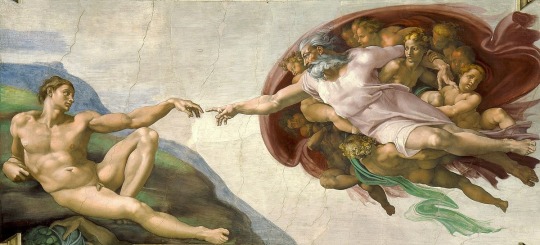
"The Creation of Adam" or "The Creation of Man" is a fresco painting by Michelangelo for the ceiling of the Sistine Chapel in early 16th century. This painting depicts God outstretching his right hand and finger towards Adam, the first man. This is mirrored and reversed by Sunday outstretching his right hand and finger from below toward the hand appearing from the sky. It is mirrored because in the original fresco, it is God reaching out for human with his right hand and Adam reaching out with his left hand, while in the game, the mysterious hand is a left hand while Sunday reaches out with his right hand. It is reverse because in the fresco, it is God who reaches out for human, while in the game, it is Sunday, a mortal, reaching up for the deity. However, we still don't know to whom that hand in the cutscene belong, I have compared that hand with both Xipe's and Ena's in their models, and it doesn't seem to belong to either of them, although the hand looks more like Xipe's than Ena's.
5. And on the eighth day
"And on the eighth day" is the name of the last quest of the trailblaze mission/main story quest chain of Penacony that was released in version 2.2.
In the quest, we hear Sunday telling us what Ena the Order did within the first seven days of Their existence. This is based on the narrative in the first chapter of Genesis, the first book of the Bible, God created everything in six days and He rested on the seventh day. If you have done the side quest to find clues about Sunday's whereabouts for Robin, you will get a notebook with the account of what Ena did in the seven days, the notebook is also divided into numbered chapters and verses, like the Bible.
Now we come to "the eighth day". In the 3rd phrase of the boss fight, each time the boss's turn comes, it doesn't attack but count the 7 days with its turns, corresponding with the narrative of Ena's first 7 days. And even on the 7th turn, the boss doesn't attack. It attacks on its next/8th turn after the cutscene, representing the eighth day.
Now in Catholicism, the day that Jesus rose from the dead is Sunday, the first day of the week. But Sunday is after the seventh day of the week, Saturday, so it's also called the eighth day.
"The eighth day, that is, the first day after the Sabbath [loosely corresponding to Saturday], was to be that on which the Lord should rise again, and should quicken us, and give us circumcision of the spirit." St. Cyprian of Carthage
"God brought it about that Christ’s body rested from all His works on the Sabbath in the tomb, and that He rose from the dead on the third day, which we call the Lord’s Day, the day after the Sabbath, and therefore the eighth day." St. Augustine of Hippo
6. Penacony's Phonograph soundtracks
I said that I also found some religious elements with Penacony. And I found those references with many of Penacony's phonograph soundtracks.
City Upon a Hill - the name is deprived from Jesus's words in Sermon on the Mount. You are the light of the world. A city seated on a mountain cannot be hid. (Matthew 5:14)
The Strength of Sin is the Law and The Sting of Death is Sin - now both of these came from the words of St. Paul the Apostle in his first Epistle (letter) to the Corinthians in the Bible, words for words. The sting of death is sin, and the strength of sin is the law. (1 Cor. 15:56)
Infirma Nostri Corporis - this is a phrase from traditional Catholic hymn Veni Creator Spiritus - Come, Holy Spirit, Creator. The phrase is an invocation of the Holy Spirit to strengthen our mortal body full of frailty and weaknesses.
Requiem Aeternam - eternal rest, this is a introit (hymn that is sung when the priest enters the church at the beginning of Mass). This introit is used at a Requiem Mass or Mass for the deceased or funeral Mass, a prayer to ask God to grand eternal rest to the deceased. Mozart wrote his own Requiem, which I believe to be the direct inspiration for this soundtrack and the next four. That means the original Catholic hymns are indirect inspirations.
Confutatis - confusion, this is a part of Sequence Dies Irae (Day of Wrath), which tells us about the Last Judgement. Confusion here means the confusion of the reprobate if you want the full context of this particular phrase. Also a part of Mozart's Requiem Mass.
Hosanna in Excelsis - Hosanna in the highest (hosanna is a word that expresses adoration, joy and praise). This originally came from the words of the crowd when they acclaimed Jesus at his Entrance into the city of Jerusalem. (Matt. 21:1-11; Mark 11:1-11; Luke 19:28-44; John 12:12-19). This was later incorporated into the praise Sanctus, which is sung at every Mass. Being an ordinary part of the Mass, the Sanctus is also a part of Mozart's Requiem.
Agnus Aeon - Lamb of Aeon, this is inspired by Agnus Dei - Lamb of God, another hymn that is present at every Mass. The hymn itself was inspired from the Bible, when St. John the Baptist called Jesus "the Lamb of God" (John 1:36). In Star Rail universe, when saying "god", the Aeons come to mind and the soundtrack's name was subsequently adopted to fit in the story. Also a part of Mozart's Requiem, same case with Sanctus.
Lux Aeterna - eternal light, the name comes from the hymn that is sung at the end of the Requiem Mass. The whole context is a prayer to God to let eternal light shine upon the departed.
7. Xipe - the Triple-Faced Soul

One of Xipe the Harmony's titles is the Triple-Faced Soul, and you can see They have three faces (or heads?) from Their model. They are also called "thousand faces", but here I'll be discussing the Triple-Faced only.
Now Xipe's three faces reminds me of the Holy Trinity, especially the depiction of the Trinity as Trifacial.
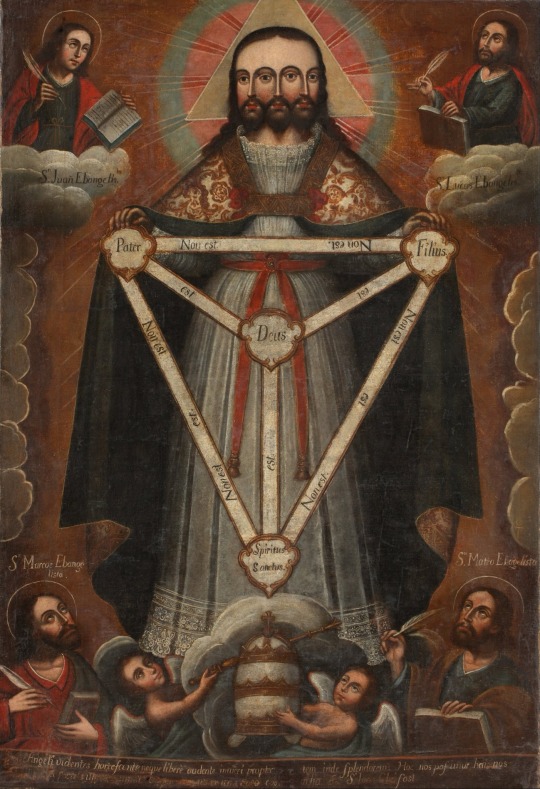
This kind of depiction of the Holy Trinity is not allowed anymore after the 1628 ban of Pope Urban VIII, who feared the depiction could make the people confused about the doctrine of the Trinity.
While the Trinity in Christianity is Three Distinct Persons but one God, one Divinity, Xipe is one person with three faces as symbolism.
I do know that gods in Hinduism have multiple heads, but I have only seen gods with 4 heads, 5 heads or even 8 heads. The only time I see a three-head god is when they depict Brahma, Vishnu and Shiva together as the Trimurti.
Well, those are all the Catholic references I could find and remember. Feel free to tell me if I missed something :3
110 notes
·
View notes
Text

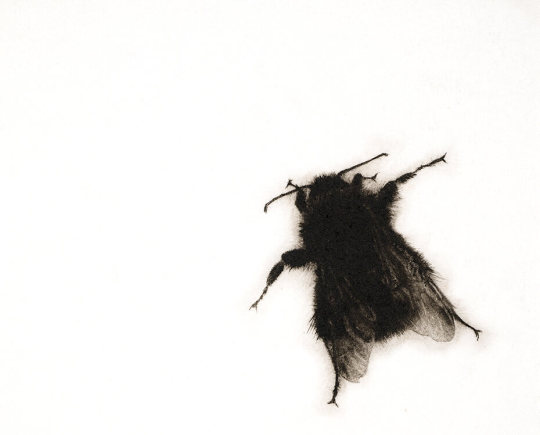
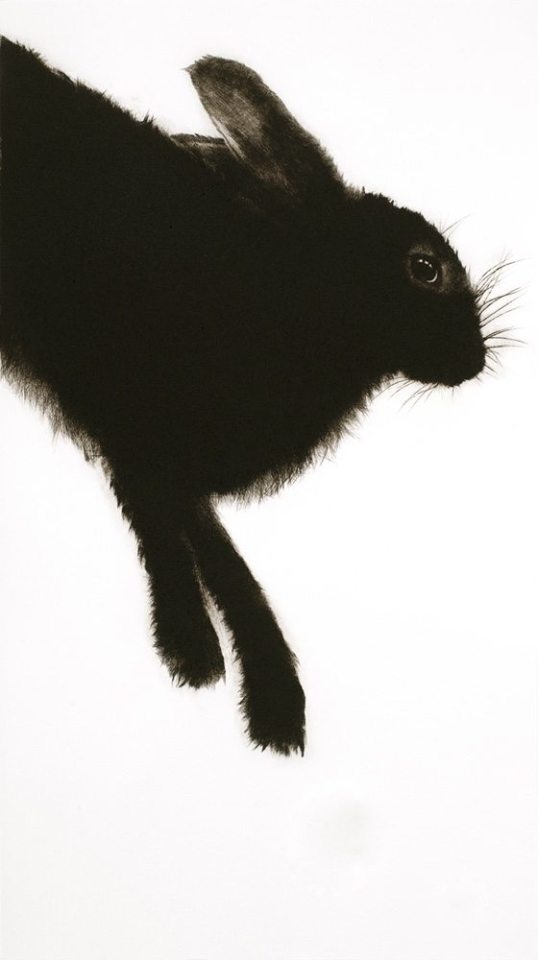


British artist Sarah Gillespie's early Mezzotints and Drypoints.
Sarah tells:
"I’m an artist, not an entomologist – nor do I have a background in natural history. But I’ve always lived in the countryside, apart from the years when I was studying. I’ve always walked and I’ve had the habit of solitude, really, so looking at nature is part of my DNA. I don’t even like saying “looking at nature” because it implies a subject-object dualism, which I’m not interested in. I did want to study biology, but I come from the era when they wouldn’t let you do both sciences and arts. You had to choose.
I grew up and went to school in Hampshire, then failed to get into art school. My dad, being an Irish immigrant, said, “Come on, then, let’s let’s go elsewhere. If you want to paint, let’s go to Paris.” He found a little art school in Paris and literally put me in the car with a portfolio and took me for an interview. So I went to Paris for a year and studied 16th- and 17th-century methods and materials with some extraordinary people in an old fashioned atelier. This was unheard of in England. We had a master, worked very long hours, and everybody cooked and helped. We worked and worked. It was a fantastic grounding.
From there, my parents said I had to apply to university, so I ended up at Oxford at the Ruskin School of drawing and fine art. I learned pretty much nothing during three years in the painting school, but I did learn a great deal in the printmaking studios. I was happier there. I found the painting too narcissistic and egotistical, and not sufficiently grounded in technique.
Afterwards I just wanted to start painting. I won quite a large international bursary on leaving Oxford, enough for me to live on for about three years, which was life changing. I haven’t looked back. I’ve been painting and drawing ever since."
59 notes
·
View notes
Text
round 3, poll 2
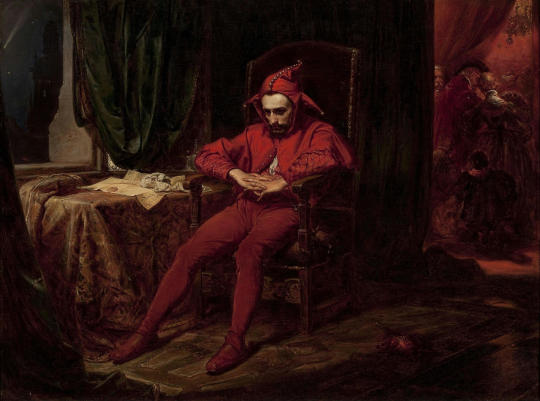
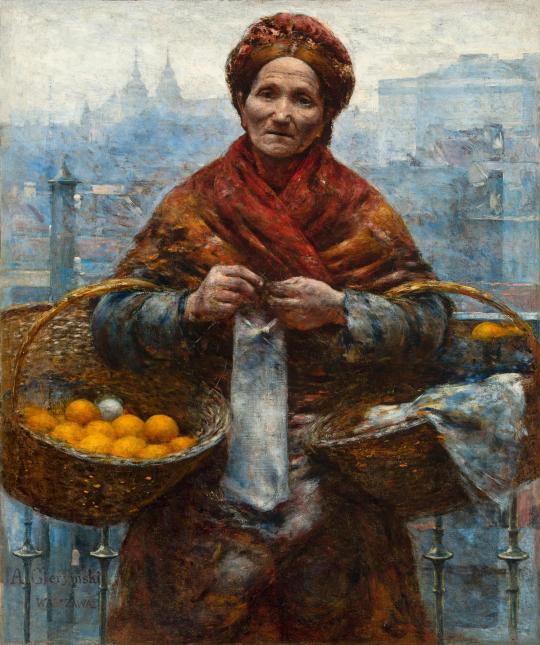
Stańczyk:
painted in 1862
i generally dislike matejko but stańczyk is so iconic that i've grown to like it
long story short Stańczyk was a court jester for the last kings of the Jagiellonian dynasty in Poland in 16th century. he was also politically savvy and known for his accurate satirical comments on the country's past and present political situation.
in the painting he has just read the letter announcing some significant war losses (the fall of Smolensk); he is somber, but in the background, behind the curtain, the royals having fun at a ball and remain ignorant of the news
it's one of Matejko's early paintings; he was just 24 when he finished it
it's also an autoportrait since Matejko gave Stańczyk his own face
Żydówka z pomarańczami:
painted in 1881
looted during ww2 and recovered after almost 80 years!
portraits of elder people are always so good
there is something very pleasing about the blue-orange colour combination
instead of a live model Gierymski probably used this photo as a reference - the woman really is recognizable!
see more of their works! Matejko, Gierymski
117 notes
·
View notes
Text
Finally I'm able share some good news
Wild festivals, exquisite fruit-bowls and unusually realistic renderings of motherhood and female friendship – not to mention a glimpse of Lady Hamilton as an enthusiastic follower of Bacchus – will go on show in Madrid on Tuesday as one of the country’s most famous galleries seeks to spike the patriarchal canon of art history with a new, and avowedly feminist, exhibition.
The show at the Thyssen-Bornemisza – called simply Maestras (Women Masters) – uses almost 100 paintings, lithographs and sculptures to show how female artists from the late 16th to the early 20th centuries won recognition in their own lifetimes, only to find their works forgotten, erased or consigned to dusty storerooms.
Organised into eight chronological sections that reflect artistic and social changes, Maestras also explores how female artists, gallerists and patrons worked together to create and celebrate art while living and working in the grip and gaze of sexist, and often misogynistic, societies.

Elizabeth Sparhawk-Jones, The Shoe Shop, 1911. Photograph: Elyse Allen/© Art Resource, New York Scala, Florence
Seventeenth-century works by Artemisia Gentileschi, Fede Galizia and Elisabetta Sirani give way to still lifes of fruit and flowers before the exhibition moves to portraits – including Élisabeth Louise Vigeé Le Brun’s Lady Hamilton as a Bacchante – and then to Orientalism, depictions of working women, images of maternity, sisterhood and, finally, to images of female emancipation.
Among the show’s early exhibits is one of Gentileschi’s anguished studies of Susanna and the Elders, while the later pieces include Mary Cassatt’s bleary-eyed Breakfast in Bed and Maruja Mallo’s playful Fair pictures.
“This exhibition speaks positively of that other half of art history,” said the exhibition’s curator, the art historian and critic Rocío de la Villa.
“For a long time, the feminist history of art has been beset by all the handicaps and obstacles that had been put in the path of female creators. For example, they couldn’t access the same artistic training that their male colleagues could. They generally lived in an extremely patriarchal system that denied them their rights and in which their signatures had no legal value.”
There were, however, “certain moments and certain places” in which conditions were more favourable to female artists, and the show aims to offer “a series of windows through which we can see a mutual understanding and a camaraderie between artists, gallery owners and patrons”.
It also reminds visitors that some talented women caught the eye of European royal courts, and that some had husbands who helped them in the studio – or even looked after their children – because they knew that their wives’ gifts far exceeded their own.
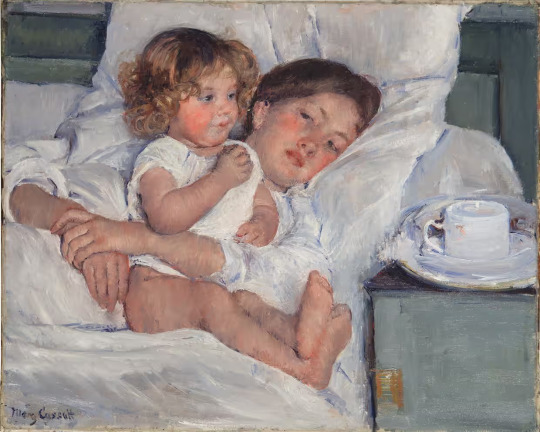
Mary Cassatt, Breakfast in Bed, 1897. Photograph: The Huntington Library, Art Museum
Guillermo Solana, the artistic director of the Thyssen-Bornemisza, said Maestras was another example of the museum’s continuing commitment to feminism, education and addressing the prejudices of the past.
“I’d promised myself that I wouldn’t do any mansplaining today but I can’t help it when it comes to explaining what I’ve learned from the process of doing this exhibition, because I’ve learned a lot,” he told journalists on Monday morning.
“The first thing I learned from this exhibition – and which I think the public will also learn – was so many new names; so many fantastic artists I’d had no idea about and had never heard of. Of course, we knew about Artemisia Gentileschi and Frida Kahlo or Paula Modersohn-Becker, but how many important artists have got away – or been taken from us?”
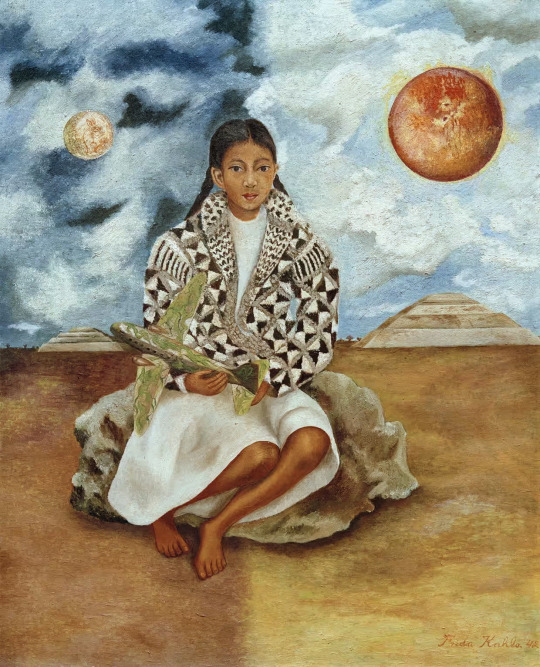
Frida Kahlo, Portrait of Lucha María, A Girl from Tehuacán, 1942. Photograph: akg-images/© Rafael Doniz @ 2023 Banco de México Diego Rivera Frida Kahlo Museums Trust, México, D.F./VEGAP
De la Villa agreed. “The public is going to ask, ‘How can it be that we didn’t know about these female artists?’” she said.
“How is it that their works were in storerooms until recently? Maestras is a feminist exhibition that seeks to emphatically correct the prejudices that have come about as a result of the patriarchy – prejudices that have meant that works by female artists have remained in museum storerooms during the 20th century.”
She said the male-dominated artistic system had always sought to defend itself by denigrating female artists. Equally damaging, she added, was how historians had played down the achievements of women until their voices were silenced and their creations overlooked and then hidden from view.
“When women are hidden, or robbed of their past, they are robbed of their identity,” said De la Villa. “The power of culture is very important. It just can’t be separated from the social conditions we enjoy, or which we suffer.”
Maestras is at the Thyssen-Bornemisza museum from 31 October to 4 February 2024
#Spain#Madrid#the Thyssen-Bornemisza#Maestras (Women Masters)#Elizabeth Sparhawk-Jones#mary cassatt#frida kahlo#October 31st to February 4th 2024
108 notes
·
View notes
Text
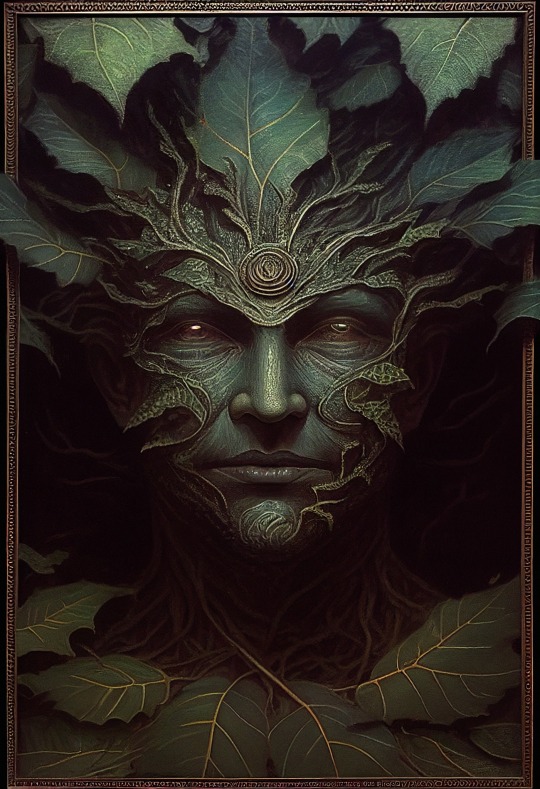
The Enigma of the Green Man
Symbol of life and nature:
The Celtic nature god Cernunnos from the Gundestrup Cauldron (1st Century BCE, now in the National Museum of Denmark in Copenhagen)
The Celtic nature god Cernunnos from the Gundestrup Cauldron (1st Century BCE, now in the National Museum of Denmark in Copenhagen)
The most common and perhaps obvious interpretation of the Green Man is that of a pagan nature spirit, a symbol of man’s reliance on and union with nature, a symbol of the underlying life-force, and of the renewed cycle of growth each spring. In this respect, it seems likely that he has evolved from older nature deities such as the Celtic Cernunnos and the Greek Pan and Dionysus.
Some have gone so far as to make the argument that the Green Man represents a male counterpart - or son or lover or guardian - to Gaia (or the Earth Mother, or Great Goddess), a figure which has appeared throughout history in almost all cultures. In the 16th Century Cathedral at St-Bertrand de Comminges in southern France, there is even an example of a representation of a winged Earth Mother apparently giving birth to a smiling Green Man.
Because by far the most common occurrences of the Green Man are stone and wood carvings in churches, chapels, abbeys and cathedrals in Europe (particularly in Britain and France), some have seen this as evidence of the vitality of pre-Christian traditions surviving alongside, and even within, the dominant Christian mainstream. Much has been made of the boldness with which the Green Man was exhibited in early Christian churches, often appearing over main doorways, and surprisingly often in close proximity to representations of the Christ figure.
Incorporating a Green Man into the design of a medieval church or cathedral may therefore be seen as a kind of small act of faith on the part of the carver that life and fresh crops will return to the soil each spring and that the harvest will be plentiful. Pre-Christian pagan traditions and superstitions, particularly those related to nature and trees, were still a significant influence in early medieval times, as exemplified by the planting of yew trees (a prominent pagan symbol) in churchyards, and the maintenance of ancient “sacred groves” of trees.
Tree worship goes back into the prehistory of many of the cultures that directly influenced the people of Western Europe, not least the Greco-Roman and the Celtic, which is no great surprise when one considers that much of the continent of Europe was covered with vast forests in antiquity. It is perhaps also understandable that there are concentrations of Green Men in the churches of regions where there were large stretches of relict forests in ancient times, such as in Devon and Somerset, Yorkshire and the Midlands in England. The human-like attributes of trees (trunk-body, branches-arms, twigs-fingers, sap-blood), as well as their strength, beauty and longevity, make them an obvious subject for ancient worship. The Green Man can be seen as a continuing symbol of such beliefs, in much the same way as the later May Day pageants of the Early Modern period, many of which were led by the related figure of Jack-in-the-Green.
Symbol of fertility:
Although the Green Man is most often associated with spring, May Day, etc, there are also several examples which exhibit a more autumnal cast to the figure. For example, some Green Men prominently incorporate pairs of acorns into their designs (there is a good example in King's College Chapel, Cambridge), a motif which clearly has no springtime associations. In the same way, hawthorn leaves frequently appear on English Green Men (such as the famous one at Sutton Benger), and they are often accompanied by autumn berries rather than spring flowers. The Green Man in the Chapelle de Bauffremont in Dijon (one of the few to retain its original paint coloration) shows quite clearly its leaves in their autumn colours.
This may have been simple artistic license. However, acorns, partly due to their shape, were also a common medieval fertility symbol, and hawthorn is another tree which was explicitly associated with sexuality, all of which perhaps suggests a stronger link with fertility, as well as with harvest-time.
Symbol of death and rebirth:
Green Man in the form of a skull on a gravestone in Shebbear, Devon, England (photo Simon Garbutt)
Green Man in the form of a skull on a gravestone in Shebbear, Devon, England
The disgorging Green Man, sprouting vegetation from his orifices, may also be seen as a memento mori, or a reminder of the death that await all men, as well as a Pagan representation of resurrection and rebirth, as new life naturally springs out of our human remains. The Greek and Roman god Dionysus/Bacchus, often suggested as an early precursor of the Green Man, was also associated with death and rebirth in his parallel guise as Okeanus.
Several of the ancient Celtic demigods, Bran the Blessed being one of the best known, become prophetic oracles once their heads had been cut off (another variant on the theme of death and resurrection) and, although these figures were not traditionally represented as decorated with leaves, there may be a link between them and the later stand-alone Green Man heads.
There are several examples of self-consciously skull-like Green Men, with vegetation sprouting from eye-sockets, although these are more likely to be found on tombstones than as decoration in churches (good examples can be seen at Shebbear and Black Torrington in Devon, England). Such images might be interpreted as either representing rebirth and resurrection (in that the new life is growing out of death), or they might represent death and corruption (with the leaves growing parasitically through the decaying body).
The Green Man by Talon Abraxas
40 notes
·
View notes
Text
House Flags
The custom of flying a house flag to identify a merchant ship is much older than you might think, as such flags have been in use since the 16th century. But what are house flags? Well, it is the flag or later painted funnel of a merchant vessel/ steamer that makes it easier to recognise a ship in a harbour and to identify who the ship belongs to.
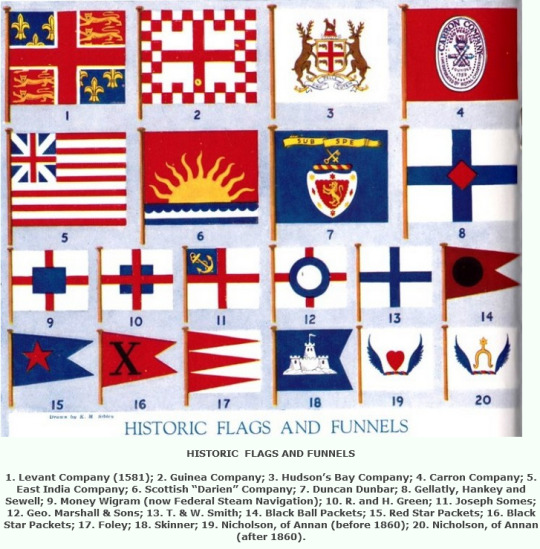
What exactly was meant by this is somewhat controversial, as some believe that it only refers to the owner of the ship. Others believe it refers back to the companies to which the ship belonged. Since there are these points of contention, the dating is always viewed differently. Some date it as early as the 16th century with the emergence of the early companies or as late as the mid 19th century.
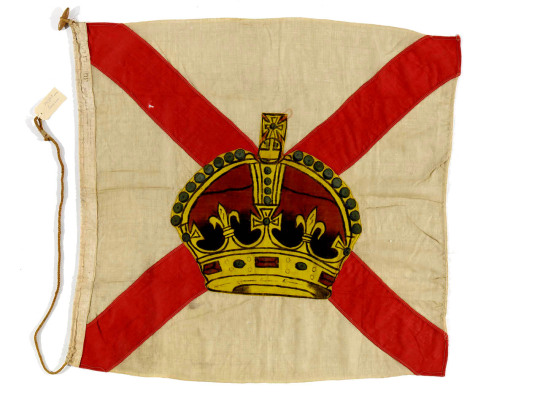
House flag, Royal Mail Lines Ltd., 1955- 67
It is a matter of definition, but it can be said that these flags and later painted funnels of recognition have appeared since the 17th century and are still carried by merchant ships today to indicate their affiliation.
#naval history#naval artifacts#house flags#just a short definition#16th - today#age of sail#age of steam#merchant service
59 notes
·
View notes
Text
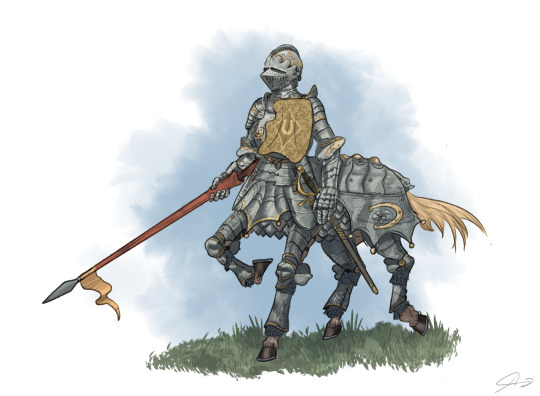
Some fantasy artwork, an early 16th century centaur I commissioned from Anton Paluch.
The horse armor is based on the following painting of Albrecht May on horseback, ca. 1490-1510, while the human armor is based on the Wallace Collection A30, which you can learn more about here.


495 notes
·
View notes
Text
So how did we get from this
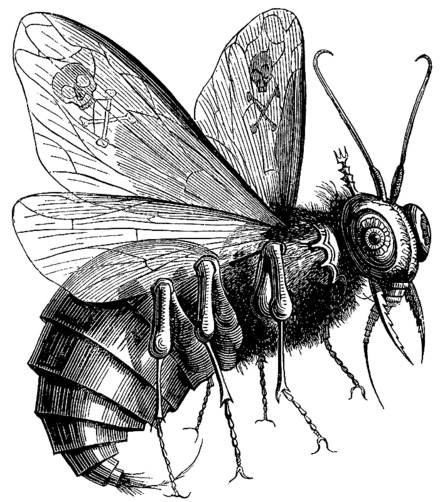
To this?

Let's talk about the history of Beelzebub!
Beelzebub is strongly associated and indeed often conflated with Baal, a Hellenistic era pagan god worshipped everywhere from the Canaanite city of Ekron to Greece (where he was known as Belus) to Egypt as far back as 1400 BCE. He is first mentioned in the Books of Kings (2 Kings 1:2–3, 6, 16) as Ba'al-zəbûb, meaning "Lord of the Flies" in Hebrew, a possible corruption of "Lord of the High Place" meant to denigrate the deity after he was appropriated and repurposed as a false god, then a demon. Baal worship was extremely difficult for the early Christians to stamp out, so they basically stole other people's mythology and used it as a free idea bucket to fill out the Bible's rogues gallery.
While it's true that in some Ugaritic texts, Baal is depicted as expelling flies and causing sickness, he was still held in high esteem in ancient Canaan and Phoenicia as a powerful deity who controlled the sun, storms, and fertility and who defeated Mot, the god of death and the underworld. The ancient world could get pretty scatological at times! After all, one of Beelzebub's contemporaries, the Egyptian sun god Ra, was often depicted as a dung beetle, then a prominent symbol of rebirth.
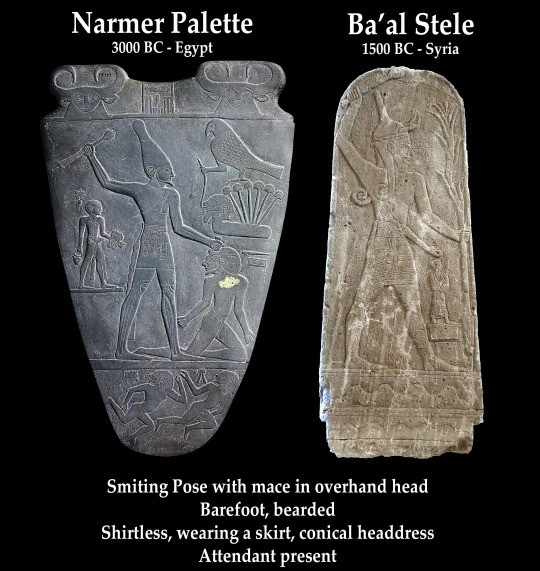
Some scholars think he might have even been the same god! Beelzebub seems to have been the ancient world's go-to demon because the name has been used interchangeably with everyone from Lucifer, Satan, and even Hades in some gnostic texts.
Unfortunately, we don't have much information about Beelzebub's pre-Christian origins other than some iron age ruins in what is now modern day Israel that suggest his temples were decorated with little golden flies, which is pretty neat.
Interestingly, Jesus himself was accused of being a worshipper of Beelzebub multiple times in the New Testament. Maybe the Pharisees were projecting?

Throughout the Middle Ages, Beelzebub reappeared again in the Lantern of the Light (where he was associated with the sin of envy), De Occulta Philosophia, Princes of Hell, and other demonology texts. 16th-17th Century French Inquisitor Sébastien Michaelis elevated him to the rank of fallen angel in his book The Admirable History of Possession and Conversion of a Penitent Woman: Seduced by a Magician that Made Her to Become a Witch, translated to English in 1613. It was around this time Beelzebub started to become strongly associated with witchcraft. Michaelis should know; he burnt over 14 women accused of being witches!
Unsurprisingly, his name came up repeatedly during the Salem witch trials.
Beelzebub and fellow demons new and old bounced all over different classifications of demons during the 1500s and 1600s. In John Milton's epic poem Paradise Lost, first published in 1667, Beelzebub was part of an unholy trinity consisting of him, Lucifer, and Astaroth. Occultist Johan Weyer decreed that Beelzebub was the Emperor of Hell, having led a successful revolt against the devil. German theologian Peter Binsfield described him as the Prince of Gluttony in his 1589 Treatise on Confessions by Evildoers and Witches. Before that, he was associated with Envy, then Pride.
We even have his personal signature! (At least according to the Grand Grimoir, an anonymous text on black magic of unknown origin)

Beelzebub's physical appearance is even more diverse. He's been depicted as everything from a leopard, a feminine man as tall as a tower, a snake, a calf with a fly's face to...whatever the literal hell this is:
"'dressed like a bee and with two dreadful ears and his hair painted in all colors with a dragon's tail"


Jacques Albin Simon Collin de Plancy (1793 – 1881)'s Dictionnaire infernal was among the first to depict Beelzebub literally as a fly. No duck feet, no lion's mane. Just a fly.
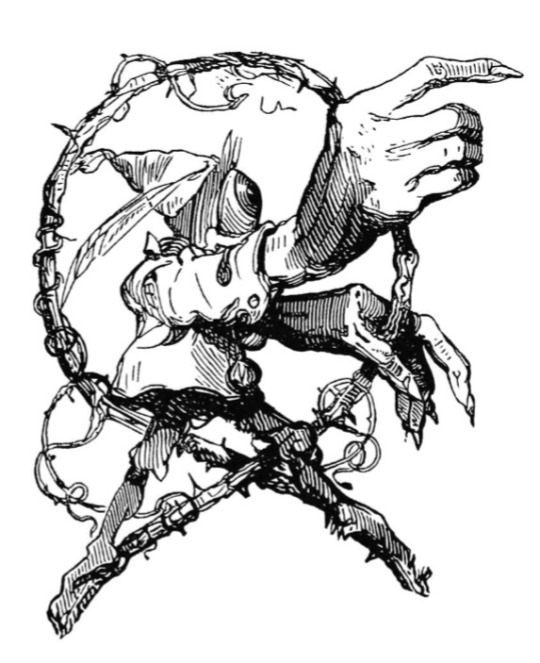
Still better than this.
As Plancy was a skeptic influenced by Voltaire, the book was first intended as a folklore compilation but was later modified to fit with Roman Catholic theology after he converted, much to the consternation of his admirers. Many of his lurid illustrations later appeared in S. L. MacGregor Mathers's edition of The Lesser Key of Solomon...for better or for worse.

Put Adrammelech in Helluva Boss you cowards.
So basically, Beelzebub has been a public domain character since before King Tut was laid in his golden sarcophagus, and people have been just making shit up about him for millennia. What's your favorite depictation of Beelzebub? This is mine:

Nothing beats 2nd Edition Dungeons & Dragons artwork.
#helluva boss#queen bee#beelzebub#character design#meta#demonology#history#mythology#long post#vivziepop#dandelion watches hellaverse#religion
37 notes
·
View notes
Text
THIS DAY IN GAY HISTORY
based on: The White Crane Institute's 'Gay Wisdom', Gay Birthdays, Gay For Today, Famous GLBT, glbt-Gay Encylopedia, Today in Gay History, Wikipedia, and more … March 5



1534 – On this date the Italian painter Correggio died (b. 1489). Born as Antonio Allegri Correggio in Parma, he was the foremost painter of the Parma school of the Italian Renaissance, who was responsible for some of the most vigorous and sensuous works of the 16th century. In his use of dynamic composition, illusionistic perspective and dramatic foreshortening, Correggio prefigured the Rococo art of the 18th century. According to some sources he was born in 1494.
Correggio infused all of his figures—male and female alike—with an intense voluptuousness that transcends any limitations of gender. His depiction of exquisite androgynous youths has made him a favorite among gay male viewers in the modern era.

Danaë
Among prominent homosexuals in late nineteenth-century Britain, Oscar Wilde shared admiration for Correggio's art with John Addington Symonds , and Wilde sought out his paintings during his trip to Italy in 1875. The homoerotic qualities of Correggio's paintings have continued to be appreciated by gay viewers in recent decades.
Frequently included in lists of famous gay historical figures, Correggio is among the fifty-two individuals whose name is recorded on Into the Light, the mural covering the dome in the Gay and Lesbian Center of the San Francisco Public Library.
Correggio's The Rape of Ganymede was the first large-scale Renaissance oil painting of the subject. Correggio shows Jupiter, in the guise of an eagle, lifting the shepherd boy high above the lush blue-green landscape, while a dog jumps excitedly up toward his young master.

The Rape of Ganymede
With his face encircled by soft curls, Ganymede gazes out seductively at the viewer, even as he embraces the eagle. The dark feathers of the eagle help to set off the glowing pink flesh tones of the youth, who is shown at a three-quarter angle with much of his backside visible. Wind blows the pink draperies away from Ganymede's smooth, radiant buttocks, so that these are fully exposed to the viewer. Jupiter's understandable attraction to the beautiful youth is revealed by the way that the eagle tenderly licks at the boy's wrist.
The early acknowledgment of Correggio's Ganymede as a quintessential representation of homoerotic desire is indicated by the numerous references to the painting in the proceedings, conducted by the Spanish Inquisition against the wealthy connoisseur Antonio Pérez (1534-1611) on charges of sodomy. During the lengthy trial (which lasted from 1579 until 1590, when Pérez escaped to France), his ownership of Correggio's Ganymede was repeatedly cited as proof of his inclination to commit homosexual acts.


1922 – the Italian poet, intellectual, film director, and writer Pier Paolo Pasolini, was born on this date (d. 1975). Pasolini distinguished himself as a philosopher, linguist, novelist, playwright, filmmaker, newspaper and magazine columnist, actor, painter and political figure. He had a unique and extraordinary cultural versatility, and in the process became a highly controversial figure.
While openly Gay from the very start of his career (thanks to a sex scandal that sent him packing from his provincial hometown to live and work in Rome), Pasolini rarely dealt with homosexuality in his movies. The subject is featured prominently in Teorema (1968), where Terence Stamp's mysterious God-like visitor seduces the son of an upper-middle-class family; passingly in Arabian Nights (1974), in an idyll between a king and a commoner that ends in death; and, most darkly of all, in Salò (1975) [banned in many countries throughout Europe and North America], his infamous rendition of the Marquis de Sade's compendium of sexual horrors, The 120 Days of Sodom.
In 1964 he found his public moviemaking "voice" with The Gospel According to St. Matthew. With a non-professional cast and a quasi-documentary shooting style, Pasolini retold the familiar story of the life of Christ in the simplest, least-Hollywood-like style imaginable.
For a time a Christian fundamentalist film distributor had the rights to the film in the United States and successfully exhibited it to church groups. One wonders how receptive the fundamentalist audience would have been to the movie had they known that its maker was a gay, atheistic communist.
Gospel was followed by The Hawks and the Sparrows (1966), a comic fable about the adventures of a Chaplinesque father and son team, played by the great Italian star Toto and Ninetto Davoli, a young former lover of Pasolini's who was to appear in many of the filmmaker's works.
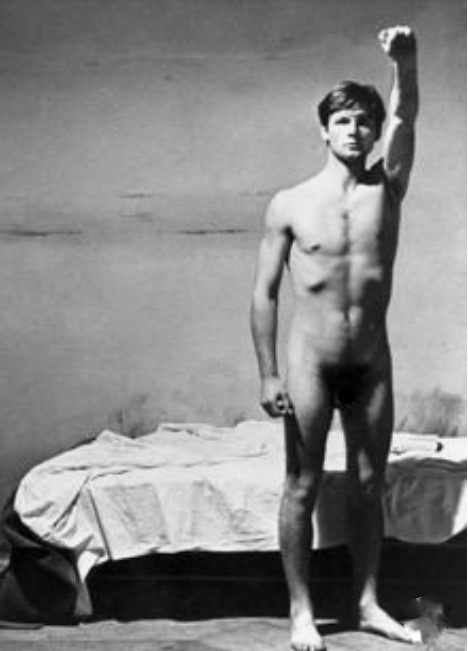
a scene from Pasolini's Salò
His most visually elegant and dramatically reserved work, Salò offers Sade's vision of old, wealthy, evil authorities (politicians, lawyers and bishops) having their way with nude and compliant youths and maidens of the lower classes as simply standard operational procedure for the powers that be.
Pasolini was open about his sexuality, his Communism, his compassion for the poor, the delinquent, and the young. He once wrote a poem for the dying Pope Pius XII that read, in part:
How much good you could have done!
And you
Didn't do it.:
There was no greater sinner than you
Pasolin's own death was a terribly banal sort of death. As far as the heterosexual status quo is concerned, Pasolini, a wealthy, older, and therefore "corrupt" man was killed by a poor and therefore "innocent" youth "disgusted" by his "advances." But, as every gay man knows, this homophobic scenario is never really the truth.
Pasolini's death (which involved the killer or killers driving over the artist's head with his own car) was a gay-bashing as certainly as was that of Matthew Shepard. The difference is that in 1975 the cultural climate was not as sympathetic to the spectacle of the death of an intellectual as it proved to be in 1998 with the death of a gay college student.


1932 – Michael Rumaker is an American author best known for his semi-autobiographical novels that document his life as a gay man in the 1950s and after.
Rumaker graduated from Black Mountain College in 1955 and later wrote a memoir of his time there. He hitchhiked to San Francisco where he encountered the literature of the Beat Generation. Returning to New York, he attended Columbia University and received an MFA in 1969, after which he began teaching writing.
His first book, The Butterfly, is a fictionalized memoir of his brief affair with a young Yoko Ono, published before Ono became famous. His short stories, Gringos and other stories, appeared in 1967. A revised and expanded version appeared in 1991. He began to write directly about his life as a gay man in the volumes A Day and a Night at the Baths (1979) and My First Satyrnalia (1981). The novel Pagan Days (1991) is told from the perspective of an eight-year old boy struggling to understand his gay self. Black Mountain Days, a memoir of his time at Black Mountain College, has a strong autobiographical element. In addition, there are portraits of many students and faculty (including the poets Robert Creeley, Charles Olson and Jonathan Williams) during its last years, 1952-1956.
Following his graduation from Black Mountain College, Rumaker made his way to the post-Howl, pre-Stonewall riots gay literary milieu of San Francisco, where he entered the circle of Robert Duncan. His account of that time in the book Robert Duncan in San Francisco gives an unvarnished look at the premier poet of the San Francisco Renaissance. Rumaker will release previously unpublished letters between himself and Robert Duncan for a new edition, published by City Lights.


1947 – Michael Mason (d.2015) was the news editor of Gay News who went on to co-found and edit the pioneering London paper Capital Gay and was a leading figure in the campaign for homosexual law reform.
Having been born in an era when homosexuality was illegal, Mason was bemused towards the end of his life to see a Conservative prime minister fighting for gay marriage. But, without his own tireless groundwork , such changes might not have happened.
Michael Aidan Mason was born in London. His father, Kenneth, was a Fleet Street journalist who later founded his own publishing house specialising in marine books.
Michael was sent as a weekly boarder to prep school in Surrey, then to Lancing College where, as well as singing in the chapel choir, he trysted happily with willing partners in the space below the school stage. It was there that he was discovered in flagrante while he was house captain.
Fortunately this did not derail his school career, and he went on to read Law at St Edmund Hall, Oxford.
In the early 1970s he encountered the Gay Liberation Front, the radical movement which offered gay people an alternative, more open, way of life to the furtive existence they had led hitherto. It completely changed his world view and he became a GLF activist.
The GLF dissolved and fragmented within a couple of years, but one of the fragments was Gay News, a hippie-style fortnightly. Excited by the concept of a gay newspaper, Mason got a job as business manager and within six months was news editor.
In 1981 Mason and his colleague Graham McKerrow broke away to set up a London-only paper called Capital Gay.
When a mystery sickness began claiming the lives of gay men in New York and San Francisco, Capital Gay appointed a medical columnist. The publication is credited by the Oxford English Dictionary as the world’s first to use the term HIV. It was ahead even of science journals, and British doctors read it to get information about the new disease from the United States. The prompt alert it offered is one reason Aids casualties were relatively low in London.
Mason’s proudest memory was being received at Grace Cathedral in San Francisco by the city’s mayor, Diane Feinstein, and asked to lead that year’s Pride parade. His lover Carl Hill had been arrested at immigration for wearing a gay badge while they were travelling to cover the event. They had become a cause célèbre, and this was San Francisco’s bid to atone.
After a decade with Carl Hill, he had a long-term relationship with David White, who later emigrated to Australia.
When Capital Gay finally collapsed in 1995 after a series of burglaries, Mason went to work as a legal secretary in a south London firm specialising in lesbian and gay immigration cases.
Soon after retirement, he was diagnosed with lung cancer which spread to his throat and his brain.


1990 – Matt Rogers is an American comedian, actor, writer, podcaster, and television host. He is best known for co-hosting the pop culture podcast Las Culturistas with Bowen Yang since 2016.
Rogers was born and raised on Long Island, New York. Rogers attended Islip High School and was named prom king at his senior prom. After graduating, he earned a BFA in Dramatic Writing from New York University. While studying, Rogers became a member of the improvisational group Hammerkatz and started studying at the Upright Citizens Brigade in 2009. It was while at NYU that Rogers first met Yang.
While studying at UCB, Rogers performed in several shows, including Characters Welcome and Amazing Welcome; he also performed in the Maude team and served as the artistic director of the musical sketch comedy group Pop Roulette. In 2016, Rogers was recognized as a "Comic to Watch" by Comedy Central. Since 2016, Rogers has co-hosted the podcast Las Culturistas with fellow NYU alumnus Bowen Yang
In 2020, Rogers hosted two television competition series. Gayme Show, co-hosted with Dave Mizzoni, was based on a popular comedy night in which straight men were quizzed on queer culture; the show aired for one season on the streaming platform Quibi. After initially being renewed for a second series, the show's current status remains in limbo following the closure of Quibi in October 2020. Also in 2020, Rogers became the host of Haute Dog, which aired on HBO Max and saw dog groomers compete for a cash prize.
As an actor, Rogers has made guest appearances on multiple television series, including Shrill, Awkwafina Is Nora from Queens, and Search Party. In 2021, it was announced that Rogers would have a starring role on the comedy series I Love That for You, in addition to a supporting role in the film Fire Island, a gay retelling of Pride and Prejudice.
He is gay, having come out while a student at NYU.


2007 – The first US soldier to be injured in the Iraq conflict, Marine Staff Sgt. Eric Alva, came out and announced his opposition to the US armed forces' "Don't ask don't tell" policy on homosexuality.

Today's Gay Wisdom:
Pier Paolo Pasolini

Pasolini, as he appeared in his own "The Decameron."
If you know that I am an unbeliever, then you know me better than I do myself. I may be an unbeliever, but I am an unbeliever who has a nostalgia for a belief. - Pier Paolo Pasolini
The mark which has dominated all my work is this longing for life, this sense of exclusion, which doesn't lessen but augments this love of life. - Pier Paolo Pasolini
One should never hope for anything. Hope is a thing invented by politicians to keep the electorate happy. - Pier Paolo Pasolini
I suffer from the nostalgia of a peasant-type religion, and that is why I am on the side of the servant. But I do not believe in a metaphysical god. I am religious because I have a natural identification between reality and God. Reality is divine. That is why my films are never naturalistic. The motivation that unites all of my films is to give back to reality its original sacred significance. - Pier Paolo Pasolini
Power has two ways of bringing racist hatred against the poor. The first point: leave them poor and a poor person comes to be hated. Make them policemen and they're accused of being killers. The moment a poor person becomes a killer he's open to racist hatred. This is horrible, we shouldn't experience this. I am obviously against the police. It's the arm upon which every power structure is built. And the power structure always tends towards the Right. I do, however, refuse to share in any type of racial hatred. - Pier Paolo Pasolini
I've never talked about the importance of the family, I'm against the family, the family is an archaic Remnant. During my childhood I had certain conflicts with my family whose background was definitely middle-class. My father represented the worst element I could imagine. It's rather difficult to talk about my relationship with my father and mother because I know something about psychoanalysis. What I can say is that I have great love for my mother. My origins are fairly typical of petty bourgeois, Italian society. I'm a product of unity of Italy as a Republic. - Pier Paolo Pasolini
I've stated various times that "Oedipus Rex" is an autobiography: my father who was an officer and my mother was more or less the woman played by Silvana Mangano. I live the Oedipus complex in a kind of laboratory fashion, in an almost elementary and schematic way. - Pier Paolo Pasolini
When I make a film I'm always in reality, among the trees and among the people; there's no symbolic or conventional filter between me and reality as there's in literature. The cinema is an explosion of my love for reality. I have never conceived of making a film that would be a work of a group, I've always thought of a film as a work of an author, not only the script and the direction but the choices of sets and locations, the characters, even the clothes. I choose everything, not to mention the music. - Pier Paolo Pasolini

From Pier Paolo Pasolini's, Roman Poems:
I WORK ALL DAY...
I work all day like a monk
and at night wander about like an alleycat
looking for love... I'll propose
to the Church that I be made a saint.
In fact I respond to mystification
with mildness. I watch the lynch-mob
as through a camera-eye.
With the calm courage of a scientist,
I watch myself being massacred.
I seem to feel hate and yet I write
verses full of painstaking love.
I study treachery as a fatal phenomenon,
almost as if I were not its object.
I pity the young fascists,
and the old ones, whom I consider forms
of the most horrible evil, I oppose
only with the violence of reason.
Passive as a bird that sees all, in flight,
and carries in its heart,
rising in the sky, an unforgiving conscience.



13 notes
·
View notes
Text
amusing bits from Martin Luther: Renegade and Prophet so far:
* "What sparked [Luther's] anger, so he later reminisced, was the preaching of a Dominican friar, Johannes Tetzel, in the nearby town of Jüterborg, who went so far as to claim that his indulgences were so efficacious that even if a person had raped the Virgin Mary they would be assured complete remission from Purgatory." used car salesman-ass strategy lol
* "...the wealth of material that has survived on Luther is so great that we probably know more about his inner life than about that of any other sixteenth-century individual... His collected works, the famous Weimar Edition, extend to 120 volumes, including 11 volumes of letters and 6 volumes of his dinner-table conversations"
holy FUCK. truly a poaster before his time. like would the median tumblr blog fill 120 volumes jeez
* "In the early years of the Reformation, for example, [Luther] talked constantly of invidia, or envy, attributing it to his opponents—though it is hardly likely that they would have envied a penniless, powerless monk, while he, on the other hand, had every reason to be preoccupied with those he envied." lmao. mean girl who goes "they're just jealous" every time ppl hate on him
* "Extraordinarily, in an age when letters were routinely passed from person to person, were forged or intercepted, and when every chancellery filed drafts, Luther kept no copies. This gave his correspondents huge power, because they alone had records of what he had written, but Luther was relaxed about this, joking that he could always deny his own 'hand,' a remark that reveals his remarkable confidence."
i will have to look into this later but this is lowkey fascinating??? it hadn't occurred to me the 16th century world would've, like. written out copies of every damn thing. to support audit trails and such. just because the overhead of producing all those damn copies seems really high. suggests fun possibilities for intrigue and mailfraud shenanigans lol
* "It was popularly believed that when of the counts [in the town where Luther grew up] commissioned an altarpiece for the chapel depicting the Crucifixion, he had the thief on Christ's right painted as his most hated co-ruler
LMAOOOooo. also reminds me of the funny story that the tobacco magnate who funded the creation of Duke University Chapel asked that the stained glass depict the 12 desciples smoking cigarettes, and the dude had to be talked out of it... though i can't find any reference to the story on the internet, sadly. did the duke chapel tour guide MAKE UP LIES to me
* Luther grew up in a family that owned a mine & it's sort of hilarious how bad all these 1500s miners were at economics. they're like. running whole mining operations but with only the haziest idea of, like. where capital comes from. how to not resource trap your way into fuckedness. etc. i dunk on economists a lot but y'know there are some concepts here that actually were p worth formalizing
* our dude Luther was a fucking DRAMA QUEEN let me tell you:
"[Luther] joined the Augustinian order in Erfurt on July 17, 1505 [...] Luther sent his academic gown and ring home to Mansfeld, telling his parents he had drawn a line under this part of his life. He sold some of the fine legal textbooks his father had bought him and donated others to the monastery. Then he invited all his student comrades to a lavish meal, with music and entertainment. At the height of the party, he told his shocked companions of his decision to become a monk, announcing melodramatically, 'Today you see me and never again!' He then left for the monastery, accompanied by his sobbing companions." bet those dudes never forgot that party
* though Martin Luther's dad sure could match him for drama queen-ness (and apparently never stopped resenting Luther becoming a monk instead of a lawyer):
"At the ensuing feast to celebrate [Luther's first mass a priest], for which Luther's father, always the man for the grand gesture, had given the sum of twenty guilders, the breach was still evident. Luther asked whether his father now accepted his decision, and in front of everyone at the table, Hans Luder replied, 'Remember the fourth commandment, to obey father and mother.' 'What if it was an evil spirit' behind [the storm that convinced Martin to become a monk]? he asked. It was a very serious charge, made at a point where Luther had just acted as Christ's representative on earth for the first time."
* Luther was in one of the more hardcore monkish orders, and said order had a pretty rigorous schedule of prayers that involved waking up in the middle of the night... but apparently you could just pay other monks to pray for you if you just Didn't Feel Like Doing It one day? lmao. and in particular Luther did the strategy of "i'll just get them done ALL IN ONE DAY" instead of, like, doing them throughout the week (going without food or sleep, working that day & night to get them done)
* our dude could definitely be a poor lil meow meow / woobie if fandom got their hands on him. this boy is constantly having literal panic attacks about WHAT IF I MISINTERPRETED THIS PART OF SCRIPTURE AND NOW WE'RE ALL GOING TO HELL, when he's in Rome one of the things that bothers him the most (besides the famous indulgence thing) is the fact that they SPEEDRAN masses over there and he's like "oh no though, i spend SO MUCH time on the masses i run, i'm so afraid of doing it without true feeling... who are these speedrunning fucks with no respect goddamn," his confessor gets tired of him because he'll spend UP TO SIX HOURS AT CONFESSION agonizing over shit that doesn't matter... (this is part of the reason he went into academia, actually, his confessor was like "boy you have got way too much anxiety for the purely monastic life, go get a degree or something i stg")
* i do kinda love it when theologians get sexy with it:
"[Staupitz] wrote of different 'stages' of union of the soul, the first being that of 'young maids in faith,' the second that of the 'concubine,' the third, the 'queens': 'They are naked and copulate with the naked one. They taste that outside Christ there is nothing sweet and they enjoy [his] continuous sweetness. For the naked Christ cannot deny himself to those naked,' while in the fourth stage, which Mary alone experienced, Jesus 'sleeps naked with her naked and he shows other signs of such love.'"
12 notes
·
View notes
Note
I’m wondering if you have any examples of Irish clothing from the early 1600s (around 1610-1615)? I haven’t been able to find much from this era so I’d appreciate any sources or museum collections that you could recommend.
Starting this out with the caveat that if you're looking for the same level of detail and precision that we have for English dress history in this period, you are going to be disappointed. The types of English primary sources we have for this period (well-dated detailed paintings, well-preserved rich-people clothing, wills, printed books, etc) just don't exist for Ireland. There also seems to be much less research interest in 16th-17th c. Irish dress history, so there isn't nearly as much for secondary sources (books, articles etc.).
You don't mention if you are interested in a specific region in Ireland. Ireland in the early 17th c. was a pretty heterogeneous place. People in Dublin and Waterford wore English-influenced styles. According to British-appointed solicitor-general Sir John Davies, by 1606 a few of the wealthier people in Connacht had started wearing English dress, but many others were still wearing Irish clothing. Ulster was a mix of Irish who were wearing Irish dress and incoming English and lowland Scots settlers.
All of the extant Irish clothing I know of from the early 17th c. comes from either bogs or archaeological excavations. It looks like you've already seen my post on extant garments at the NMI. The NMI also has a couple of felt hats that might be early 17th c. This one is from Knockfola, Co. Donegal. It originally had a decorative cord or band where the pale line is:

There are also another cóta mór and brat, found on a bog body from Leigh, Co. Tipperary, which I don't think the NMI has on display. I did not bother to include them in my post, because they are so similar to the ones from Killery, Co. Sligo, but the fact that these have been found in multiple places suggests that they were common, widely-used garments.
The other major garment-find from this period is the Dungiven outfit which is in the Ulster Museum. a short video The bright blue thread was added by a modern conservator; it's not original. (Side note: The identification of this outfit has gotten unfortunately politicized. Tartan trews were worn by both the Irish and the Scots during the 17th century (McClintock 1943, Dunlevy 1989). The presence of tartan should not be used to draw conclusions about the ethnicity of the wearer.) The primary publication for this outfit:
Henshall, Audrey, Seaby, Wilfred A., Lucas, A. T., Smith, A. G., and Connor, A. (1961). The Dungiven Costume. Ulster Journal of Archaeology, 24/25, 119-142. https://www.jstor.org/stable/20627382
The one other reasonably-well preserved outfit that has published on is from a child burial from Emlagh, Co. Kerry, now at University College Cork. Shee and O'Kelly give it a late 17th c date, but they largely base this date on the presence of a rather generic-looking comb. IMO the outfit could easily be early 17th c.

The Emlagh gown, photographed on a living 8-year-old child who was wearing a sweater and skirt underneath. (The 1960s was a different time.)
The bodice has a wrap-front closure with a back and button-up sleeves similar in cut to the Killery cóta mór. The skirt is a pleated rectangle with the pleats sewn in vertically, somewhat like the Shinrone gown. Publication:
Shee, E. and O'Kelly, M. (1966). A Clothed Burial from Emlagh, near Dingle. Journal of the Cork Historical and Archaeological Society, 71(213), 81-91.
There are also, frustratingly, a bunch of fragmentary clothing finds at the NMI which might be 17th c, but no one seems to care enough to do publications on them, and NMI Archaeology still does not have their collection on-line, so they are useless to us.
The typical Irish shoe for this period is known as a brogue (also called a Lucas type 5 by archaeologists). broguesandshoes.com has photos, a pattern, and construction information.
Unfortunately, the illustrations from Speed's map are the only images I know of from this specific period.
If you want details on what materials were used, I recommend Susan Flavin's dissertation. It's about the 16th c. economy, but things didn't change that much between 1599 and 1601. free download here
If you don't mind wading through early modern English and a bit of period-typical prejudice, I recommend reading A Discourse of Ireland, by Luke Gernon written in 1620. His description of Irish clothing starts halfway down p. 356.
Finally, if you can find them, Dress in Ireland by Mairead Dunlevy (1st ed. 1989) and Old Irish and Highland Dress by H. F. McClintock (1st ed. 1943, 2nd ed. 1950) are the best books I know of for this period.
14 notes
·
View notes
Text
What is a Handgonne ?

Author's note: this picture could use a coat of paint..
Handgonnes -from the Middle English word ‘gonne’ and possibly the old Norse 'gunnr’, “war”- were a number of hand-held firearms designs used around the world during the Middle Ages. They appeared in their earliest form in China around the 13th century as a simple barrel at the end of a haft, being an improvement on the earlier fire lance. In that configuration, gonnes are sometimes called tiller guns, and were generally cradled under the user’s arm like a couched lance to be fired.

These early firearms were often used defensively in European siege warfare by the mid-14th century, and around 1400 some of them became fitted with hooks to put over a city or castle’s wall and absorb recoil. This seemingly minor improvement gave us the German word Hakenbüchse, leading to hackbut and eventually arquebus, a name that then stuck around to designate most hand-held firearms of the Late Middle Ages and Renaissance.

The final touches to turn these simplistic ‘hook guns’ into early modern arquebuses came from fitting them with crossbow tillers, which later evolved into proper stocks for shouldering the weapon, and then in the last quarter of the 15th century to fit them with triggers for the first time in the form of a serpentine. Handgonnes before were fired by holding a slow match or heated piece of wire to a touch-hole or flashpan at the back of the barrel ; the serpentine lock simply held one such piece of slow match, made of a piece of hemp or flax cord treated with saltpeter, in a mechanism inspired by crossbow triggers.

This first type of matchlock mechanism was improved upon in the 16th century, possibly by the Portuguese, and turned into the snap matchlock where the serpentine was held in place by spring tension until the trigger was squeezed. From then on arquebuses were slowly refined in shape, size and conformity to equip armies from Europe to Japan and Ethiopia.
Related Vocabulary
couleuvrine: from the French ‘couleuvre’, a type of snake, usually refers to longer bronze guns. Later refers to artillery pieces.
double hackbut: from the German ‘Doppelhaken’, “double hook”, refers to a type of large arquebus fired either from a wall or a small wheeled rest.
touch-hole: the hole in the barrel used to ignite the powder charge within. It is often accompanied by a flash pan, a small pan where priming powder is poured to more easily and reliably fire the gun.
187 notes
·
View notes
Text
round 2, poll 2
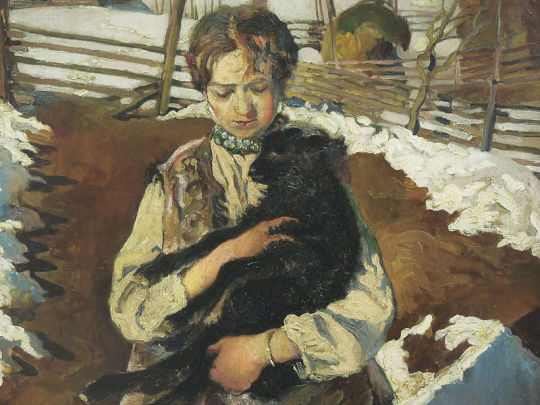
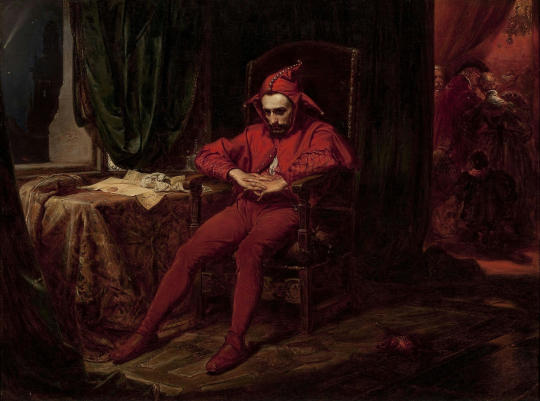
Czarne jagnię:
painted in 1905
who doesn't wanna hug a black lamb. sweet baby. stupid idioms
this is just so tender
winter air cold and damp.... baby sheep warm and cuddly....
like Axentowicz from the previous poll Sichulski also often portrayed the Hutsuls in his paintings; this painting is counted among them
Stańczyk:
painted in 1862
i generally dislike matejko but stańczyk is so iconic that i've grown to like it
long story short Stańczyk was a court jester for the last kings of the Jagiellonian dynasty in Poland in 16th century. he was also politically savvy and known for his accurate satirical comments on the country's past and present political situation.
in the painting he has just read the letter announcing some significant war losses (the fall of Smolensk); he is somber, but in the background, behind the curtain, the royals having fun at a ball and remain ignorant of the news
it's one of Matejko's early paintings; he was just 24 when he finished it
it's also an autoportrait since Matejko gave Stańczyk his own face
also sort of prophetic since it was painted just a year before the Januray Uprising haha
check out more of their works! Sichulski, Matejko
104 notes
·
View notes
Text
Notes on "Ambidextrous Angle" here
Notes on "Lady Justice" here
Notes on the flowers in ep.8 here
Notes on the numbers on the car plate of No.3 and KMC here
The Colors in ep. 10
During the torture scene of LMS they went through multiple types of colors, which I found pretty interesting as someone whos studied colors and their meanings intensely over the years. And as a lot in TKV has meaning and thoughts put behind it, I wanted to make a post highlighting the scene- and the colors specifically. It will also including short historical informations about each color.
Its starts with a mix of red and orange on the tables- making it look like vermillion (a color that borders orange and red and is also often times used in skin color shading), specifically HEX color FFD400. The color will come up later again.

Interestingly enough, since ancient times the color vermillion was regarded as the color of blood- thus of life.
In Ancient Rome, the color was widely used to paint frescos, to decorate statues and produce cosmetics. It was also used in the Byzantine Empire reserved for the use of the imperial family and their administrators (used in official letters and imperial decrees) the illuminated manuscripts of the Middle Ages, in the paintings of the Renaissance, as well as in the art and lacquerware of China.
The color can also be found all over the murals in Villa dei Misteri (Villa of Mystery before 79 AD) in Pompeii.
As the color of blood and life, it fits perfectly as the starting color of the whole scene.
LMS in the meantime is illuminated by white light.
Ironically- or fitting?- its the color of innocence, purity, hope and clarity. It represents goodness, perfection and peace. Looking at the color, it purifies the mind and helps to find balance. But like every color, it also has negative aspects such as coldness, emptiness, nothingness and distance.
A lot of times, its also the color of self-reflection (VERY fitting if you’d ask me). White was one of the first colors used in Prehistoric cave art (good example are those at Lascaux in France) which feature marks and images made used calcite and chalk. Ancient Greece saw white as a sacred color (representing light and motherhood), in Rome plain white togas (togas virilis) were worn by all citizens at ceremonial occasions.
During early christian times, they adopted the romans use of white- priests wore the color during mass as for them, white was symbolic of purity, humility and virtue (reinforced by the “white lamb” which was symbolic of christ’s sacrifice for humanity).
Later, throughout the middle ages, white was strongly associated with martyrdom. It was also the commonly worn color by widows in mourning up until the 16th century- giving the color an association with death and refelection.
Illuminating a criminal like him in white is truly a choice. It does fit the intentions of the whole torture tho: redeption, hope and clarity.
In the same frame, centering the vermillion color, we can also see yellow and orange.
Yellow is the color of happiness and optimism. It clarifies and inspires the mind and helps in creativity- it also gives warmth. The negative associations with the color are caution, egotism, deception and cowardice.
Yellow is also one of the oldest colors to exist and is seen in cave paintings 17.000 years old.
Painters in the Middle Ages and Renaissance used “Indian yellow” to show an outsider. Most notably Judas Iscariot (again, pretty fitting to the whole biblical references found throughout TKV). In ancient religions, yellow was a sacred color.
Just like gold, it was seen as eternal, imperishable and indestructible.
Many religions worshipped the sun, and the sun gods were depicted wearing yellow. The Ancient Egyptians believed the gods had gold skin and bones and used yellow for their skin tone in art. Yellow is also an important color in Buddhism, signifying humility. It can also be found in paintings from Ancient Rome.
Orange symbolizes youth, enthusiasm and optimism. It uplifts and stimulates the mind. Its the color of creativity, warmth and spontaneity. On the other hand, it shows domination and impatience. Up until the 16th century it was called “saffron” or “yellow-red”. When Portuguese merchants brought orange trees to Europe from Asia in the late 15th and early 16th centuries, the citrus fruit’s name was adopted for the general color.
In some cultures, orange is regard as a sacred color because it balances red’s power and yellow’s perfection. Monks and holy men in some Asian religions, like Buddhism, wear orange robes because that dye has been readily available historically.
Buddhists also connect orange to the highest state of illumination. Its also the color of transformation in Confucianism. and a symbol of royalty.
Again, two colors highlighting the personalties of both LMS and KSJ in a well done way.
The color then changes to a dirty blue hue- with a slight turquoise shade.

Blue- the color of loyalty and trust. It gives the feeling of security, trust, confidence, peace, honesty and reliability. It calms and relaxes the brain. Negative feelings associated with blue are passiveness, depression and prediction.
The history of the color blue is quite interesting: It was never a color to be found in nature (no, water isnt blue and the sky also changes colors and if there is indeed something blue found in nature its either with a violet or turquoise shade) thus, we humans previously were never able to even “see” the color (we perceived it, but we had no idea what it even was).
The first society to have a word for the colour blue was the Egyptians, the only culture that could produce blue dyes at around 2.200 B.C: They loved the precious stones lapis and turquoise* so much that they invented the first synthetic blue pigment in order to affordably copy their unique color. “Egyptian blue” was made by mixing silica, lime, copper, and alkali, and it could be used on stone, wood, plaster, papyrus and canvas.
Turquoise on the other hand is the color of compassion, calmness and clarity. It balances and stabilizes the brain. It can help concentrate, to grow, and underline empathy. In contradiction it also symbolizes narcissism, stress and secrecy.
The earliest evidence of turquoise* gemstones comes from Ancient Egyptian tombs: They contain elaborate turquoise jewelry dating back to 3000 BCE. Egyptians set turquoise in gold necklaces as well as in rings, used it as inlay, and carved it into scarabs. Most notably, King Tut’s iconic burial mask was extravagantly adorned with turquoise.
The oldest turquoise mines are in the Sinai Peninsula of Egypt. One sat near an ancient temple dedicated to Hathor, the Greek goddess of love and joy who was worshiped as a protector in the desert and as the patron saint of mining.
Egyptians called turquoise “mefkat”, which meant “joy” and “delight.”
-> Ancient Persians also decorated extensively with turquoise, often engraving it with Arabic script.
Turquoise covered palace domes: For them, its sky-blue color represented heaven. (This later inspired the use of turquoise in buildings like the Taj Mahal). They also adorned their daggers and horses’ bridles with it as they believed it granted protection. They would also wear turquoise gemstone jewelry around their necks and in their turbans.
-> Meanwhile, pre-Columbian Native Americans mined the turquoise stone throughout the present-day southwestern United States. Shamans used it in sacred ceremonies to commune with the spirit of the sky.
-> Apache Indians believed that attaching turquoise to bows (and later, firearms) improved a hunter’s accuracy.
-> Turquoise became valuable in Native American trade, which carried North American material toward South America.
-> Consequently, Aztecs cherished turquoise for its protective power and used it on ceremonial masks, knives, and shields.
Picking the color blue is again a really nice callback to the OST. PT3 (Blue by Aalia) and highlights the depression (or "death") KSJ went through.
Turquoise shining onto LMS face fits perfectly. The negative aspects highlight his persona.
After the blue, the color switches to green and here it is when it gets really interesting- this might be an even longer historical excurse than the turquoise one:

First we should start by looking at the positive associations to the color: It means harmony, safety, growth, health, hope, prosperity and luck. It helps the brain to revitalize, to relax and encourages. Negative aspects associated with the color are judgment, materialism and inexperience. And obviously the most famous ones: Envy and jealousy. We all know the famous saying “Green with envy”
The history of the color green dates back to the Ancient Egyptians. To produce the color they used green earth and malachite, while the Ancient Greeks used verdigris.
-> Malachite contains a high percentage of copper which makes it highly poisonous to humans when inhaling the dust or eaten. Once its polished its not poisonous anymore.
-> Verdigirs is a common name for any variety of poisonous copper salts and acetic acids. Green had a resurgence in art during the Impressionist movement due to advancements in green pigments and paints.
The bold emerald green became popular in fashion in the 1800s, used for gloves and dresses- as well as wallpapers and furniture as well as found in candy, paper, toys, medicine and dye- it was also then it became an even more poisonous color. Its name varies from “Scheele's Green”, “Paris Green” to “Emerald Green” and “Schweinfurt Green”.
And as it was probably already obvious, the color was loaded with copper arsenite which is one of the deadliest elements to have ever been found.
Scheele’s green (invented around the 1775 by the Swedish chemist Carl Wilhelm Scheele) was an artificial colorant that was made by heating up sodium carbonate, adding arsenious oxide, and stirring until the mixture was dissolved. Copper sulfate was then added as the final ingredient which ends up giving it its vibrant green color
->(Arsenic is a highly toxic substance that causes skin lesions, vomiting, diarrhea, and in some cases, cancer) As said as it was quite popular in the 1800’s countries were riddled in this substance.
->(It has also been rumored to have killed the famous Napoleon Bonaparte.)
Schweinfurt green is the product of combining copper acetate with arsenic trioxide, producing copper acetoarsenite. The toxic pigment was commercially developed in 1814 by the Wilhelm Dye and White Lead Company in Schweinfurt, Germany. It too was used everywhere, from clothing and wallpaper to colorant for fake flowers and paint.
By 1860 more than 700 tons of the pigment had been produced in the country alone.
There are stories of factory workers, mainly those who worked with fashion, suffering acid burning and losing their hair and limbs, specifically their hands, after they had been in contact with the color for way too long.
“In 1871, a lady who purchased a box of green-colored gloves at a well-known and respectable house was horrified to find that her hands broke out in blisters after putting them on. Unless the dye was sealed, sweaty palms could cause the dye to run onto the wearer’s skin. Other accounts from this era tell of babies dying in their nurseries after playing on green carpets or rubbing up against green wallpaper. One foreign dignitary even told Queen Victoria that the green wallpaper in Buckingham Palace had made him ill.”
On November 20, 1861, Matilda Scheurer, a 19-year-old artificial flower maker, died of “accidental” poisoning: The formerly healthy, “good-looking” young woman worked for Mr. Bergeron in central London, along with a hundred other employees. She “fluffed” artificial leaves, dusting them with an attractive green powder that she inhaled with every breath and ate off her hands at each meal. The brilliant hue of this green pigment, which was used to colour dresses and hair ornaments, was achieved by mixing copper and highly toxic arsenic trioxide or “white arsenic” as it was known. The press described her death in grisly detail, and by all accounts, Scheurer’s final illness was horrible. She vomited green waters; the whites of her eyes had turned green, and she told her doctor that “everything she looked at was green.” In her final hours, she had convulsions every few minutes until she died, with “an expression of great anxiety” and foaming at the mouth, nose and eyes. An autopsy confirmed that her fingernails had turned a very pronounced green and the arsenic had reached her stomach, liver, and lungs.
-> More on “Scheele’s Green” here
Green so not only fits the scene in relation to envy and jealousy, but also to its poisonous attributions. It again highlights KSJ previous personality (harmony) and LMS' (envy)- and the horrible deathly history behind the color makes it even more clear what type of person he is.
After the green, the room is then engulfed in yellow as well as vermillion (explained above) again-


Following this, the last change of color we see is red.

Associated with action, strength, energy and passion red helps to stimulate and motivate the mind, to pay attention and stay cautious. Its positive aspects are courage, desire, sexuality and confidence whereas its negative associations are anger, danger, revenge and aggression.
Throughout history, the color red has represented many things: life force, the divine to love, lust, and anger. Throughout the Middle Ages, red was a color of privilege in the Western world.
For many cultures, it was the only color worthy enough to be used for social purposes (“In some languages, the word for red was the same as the word for color”).
One of the first color developed for painting and dying, red became associated with war, wealth, and power in antiquity.
In the Middle Ages, red had a religious significance, as it was seen as the color of the blood of Christ and the fires of Hell. It also had a secular meaning: The symbolism of love, glory, and beauty. During the Protestant Reformation, red began to decline in status and fell out of favor: It was viewed as indecent and immoral as it was linked to luxury and the excesses of the Catholic Church. After the French Revolution, red gained new respect as the color of progressive movements, freedom, new liberties and radical left-wing politics.
Personally, I love how they not only picked red as the last color to highlight the anger and pain of KSJ but also how it illuminates both him and KMC in a different shade. While KSJ has the more darker red, underlining the more calmer anger, KMC is drowned in bright hot red- underlining his anger which he definitely does NOT have under control (hes holding back so much in that scene and if it wasnt for the death penalty awaiting KSJ if LMS would die, he would have killed him without hesitation). Also, the religious importance is another nice callback to all the religious imagery we have seen throughout the drama.

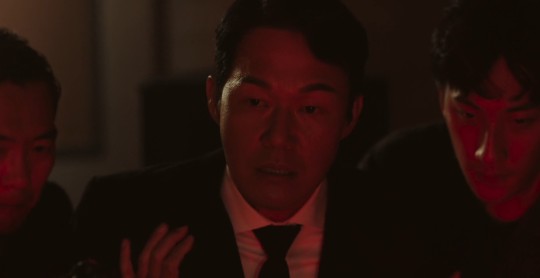
(might also add my delusions to the post: the red symbolizes the love they still feel for each other)
Intentionally or not, the way and order how they picked and presented the colors directly mirrors each character, their personal journey and the development of their anger. The fact it started with more calmer/friendlier colors and slowly turned into more agressive ones is done just beautifully.
24 notes
·
View notes
Text
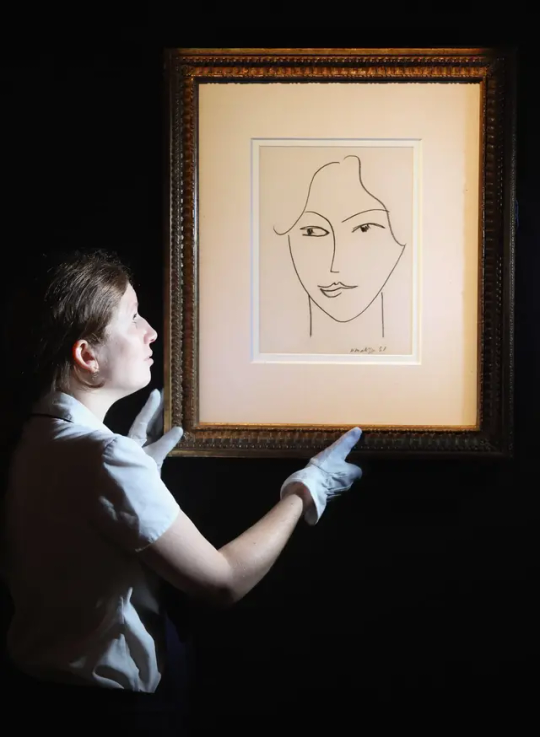
The new tool in the art of spotting forgeries: Artificial Intelligence
Instead of obsessing over materials, the new technique takes a hard look at the picture itself – specifically, the thousands of tiny individual strokes that compose it
In late March, a judge in Wiesbaden, Germany, found herself playing the uncomfortable role of art critic. On trial before her were two men accused of forging paintings by artists including Kazimir Malevich and Wassily Kandinsky, whose angular, abstract compositions can now go for eight-figure prices. The case had been in progress for three and a half years and was seen by many as a test. A successful prosecution could help end an epidemic of forgeries – so-called miracle pictures that appear from nowhere – that have been plaguing the market in avant-garde Russian art.
But as the trial reached its climax, it disintegrated into farce. One witness, arguably the world’s leading Malevich authority, argued that the paintings were unquestionably fakes. Another witness, whose credentials were equally impeccable, swore that they were authentic. In the end, the forgery indictments had to be dropped; the accused were convicted only on minor charges.
The judge was unimpressed. “Ask 10 different art historians the same question and you get 10 different answers,” she told the New York Times. Adding a touch of bleak comedy to proceedings, it emerged that the warring experts were at the wrong end of a bad divorce.
It isn’t a comforting time for art historians. Weeks earlier, in January, the Museum of Fine Arts in Ghent, Belgium, was forced to pull 24 works supposedly by many of the same Russian artists – Kandinsky, Malevich, Rodcheko, Filonov – after the Art Newspaper published an exposé arguing they were all forged. Just days before, there was uproar when 21 paintings shown at a Modigliani exhibition in Genoa, Italy, were confiscated and labeled as fakes. Works that had been valued at millions of dollars were abruptly deemed worthless.
The market in old masters is also jittery after an alarming series of scandals – the greatest of which was that paintings handled by the respected collector Giuliano Ruffini were suspect. A Cranach, a Parmigiano, and a Frans Hals were all found to be forged; institutions including the Louvre had been fooled. The auction house Sotheby’s was forced to refund $10m for the Hals alone. Many experts are now reluctant to offer an opinion, in case they’re sued – which, of course, only intensifies the problem.
Adding fuel to the fire is another development: Wary of being caught, more and more forgers are copying works from the early to mid-20th century. It’s much easier to acquire authentic materials, for one thing, and modern paintings have rocketed in value in recent years.
For many in the industry, it is starting to look like a crisis. Little wonder that galleries and auction houses, desperate to protect themselves, have gone CSI. X-ray fluorescence can detect paint and pigment type; infrared reflectography and Raman spectroscopy can peer into a work’s inner layers and detect whether its very component molecules are authentic. Testing the chemistry of a flake of paint less than a millimeter wide can disclose deep secrets about where and, crucially, when it was made.
“It’s an arms race,” says Jennifer Mass, an authentication expert who runs the Delaware-based firm Scientific Analysis of Fine and Decorative Art. “Them against us.”
But what if you didn’t need to go to all that trouble? What if the forger’s handwriting was staring you in the face, if only you could see it? That’s the hope of researchers at Rutgers University in New Jersey, who have pioneered a method that promises to turn art authentication on its head.
Instead of subjecting works to lengthy and hugely expensive materials analysis, hoping a forger has made a tiny slip – a stray fiber, varnish made using ingredients that wouldn’t have been available in 16th-century Venice – the new technique is so powerful that it doesn’t even need access to the original work: A digital photograph will do. Even more striking, this method is aided by artificial intelligence. A technology whose previous contributions to art history have consisted of some bizarre sub–Salvador Dalís might soon be able to make the tweed-wearing art valuers look like amateurs.
At least that’s the theory, says Ahmed Elgammal, PhD, whose team at Rutgers has developed the new process, which was made public late last year. “It is still very much under development; we are working all the time. But we think it will be a hugely valuable addition to the arsenal.”
That theory is certainly intriguing. Instead of obsessing over materials, the new technique takes a hard look at the picture itself: Specifically, the thousands of tiny individual strokes that compose it.
Every single gesture – shape, curvature, the velocity with which a brush- or pencil-stroke is applied – reveals something about the artist who made it. Together, they form a telltale fingerprint. Analyze enough works and build up a database, and the idea is that you can find every artist’s fingerprint. Add in a work you’re unsure about, and you’ll be able to tell in minutes whether it’s really a Matisse or if it was completed in a garage in Los Angeles last week. You wouldn’t even need the whole work; an image of one brushstroke could give the game away.
“Strokes capture unintentional process,” explains Elgammal. “The artist is focused on composition, physical movement, brushes – all those things. But the stroke is the telltale sign.”
The paper Elgammal and his colleagues November 13, 2017 examined 300 authentic drawings by Picasso, Matisse, Egon Schiele, and a number of other artists and broke them down into more than 80,000 strokes. Machine-learning techniques refined the data set for each artist; forgers were then commissioned to produce a batch of fakes. To put the algorithm though its paces, the forgeries were fed into the system. When analyzing individual strokes, it was over 70% accurate; when whole drawings were examined, the success rate increased to over 80% . (The researchers claim 100% accuracy “in most settings.”)
The researchers are so confident that they included images of originals and fakes alongside each other in the published paper, daring so-called experts to make up their own minds. (Reader, I scored dismally.) One of Elgammal’s colleagues, Dutch painting conservator Milko den Leeuw, compares it to the way we recognize family members: They look similar, but we’re just not sure why. “Take identical twins,” he says. “Outsiders can’t separate them, but the parents can. How does that work? It’s the same with a work of art. Why do I recognize that this is a Picasso and that isn’t?”
The idea of fingerprinting artists via their strokes actually dates back to the 1950s and a technique developed by Dutch art historian Maurits Michel van Dantzig. Van Dantzig called his approach “pictology”, arguing that because every work of art is a product of the human hand, and every hand is different, it should be possible to identify authorship using these telltale strokes.
The problem, though, was that there was too much data. Even a simple drawing contains hundreds or even thousands of strokes, all of which needed to be examined by the human eye and catalogued. Multiply that by every work, and you see how impractical it was.
“It just wasn’t possible to test it,” says den Leeuw, who first became aware of pictology as a student. “I saw many attempts, but mostly it ended in ideas that would never be.”
But can AI now do what humans failed to, and give an art historian’s trained eye some sort of scientific basis? “Exactly,” says den Leeuw. “Very often it’s a gut feeling. We’re trying to unpick the mystery.”
Though Mass says she’s unlikely to throw out her fluorescence gun just yet, she admits to being impressed. “A lot of people in the field are excited by AI It’s not a magic bullet, but it’ll be another tool. And it’s really valuable when you’re dealing with a sophisticated forger who’s got everything else right – paint, paper, filler, all the materials.”
There are issues. So far, the system has been tested mainly on drawings from a handful of artists and a brief time period. Paintings, which generally contain thousands more strokes, are a tougher challenge; older paintings, which might contain numerous layers of restoration or overpainting, are tougher still. “It’s challenging, but it doesn’t mean we can’t do it,” Elgammal says. “I’m confident.”
What about style, though, particularly where an artist changes over time? Think of Picasso’s wildly varying periods – blue, African, cubist, classical – or how in the 1920s Malevich abandoned the elemental abstraction of his black squares for figurative portraits that could almost have been painted by Cézanne (pressure from Stalin was partly responsible).
Another expert, Charles R Johnson, who teaches computational art history at Cornell, is less persuaded – not so much by the AI as by the assumptions that lie behind it. “A big problem is that strokes are rarely individualized,” he says. “Overlap is difficult to unravel. Plus, one must understand the artist’s style changes over their career in order to make a judgment.”
In addition, Johnson argues, many artist’s brushwork is essentially invisible, making it impossible to unpick; it might be better to focus computer analysis on assessing canvases or paper, which can be more rigorously verified. “I remain quite skeptical,” he says.
Elgammal and den Leeuw concede there’s a way to go. Currently they’re working on impressionist paintings – infinitely more complex than Schiele and Picasso line drawings – and hope to publish the results next year. Even with the drawings, the machine can’t yet be left to learn on its own; often the algorithms require human tweaking to make sure the right features are being examined. Artists whose output isn’t large enough to create a reliable data set are also a challenge.
Asking Elgammal if he’s worried about being sued. He laughs, slightly nervously. “That’s something I think about.”
It’s a reasonable question, particularly pressing given the number of fakes that are circulating: What if your database accidentally becomes contaminated? Many people argue that the art market is hopelessly corrupt – so much so that some economists doubt whether calling it a “market” is even fair. Could the algorithm become skewed and go rogue?
“It’s like any system,” Mass agrees. “Garbage in, garbage out.”
Does she think that’s a possibility? How many fakes are out there? “Put it this way,” Mass says, “when I go into auction houses – maybe not the big ones, but smaller, local ones – I think ‘buyer beware.’ It might be between 50 and 70% .”
Rival solutions are coming down the road. Some have proposed using blockchain technology to guarantee provenance – the history of who has owned a work. Others have called for much greater transparency. Everyone agrees that the system is broken; some kind of fix is urgent.
Of course, there are big philosophical questions here. When someone goes to the effort of finding exactly the right 17th-century canvas, dons an antique smock, and paints a near-flawless Franz Hals, it should perhaps make us reconsider what we mean by the words “real” or “fake”, let alone the title of “artist”. Yet the irony is inescapable. It is hard to think of something more human than art, the definition of our self-expression as a species. But when it comes down to it, humans aren’t actually that good at separating forged and authentic in a painting that has all the hallmarks of, say, a Caravaggio but is merely a stunt double. Relying on our eyes, we simply can’t tell one twin from the other. We might even ask: Why do we care?
Forget cars that pilot themselves or Alexa teaching herself to sound less like the robot she is – AI seems to understand the secrets of artistic genius better than we do ourselves.
The irony is that, while machines might not yet might be able to make good art, they are getting eerily good at appreciating it. “Yes, it’s true,” he says thoughtfully. “When it comes to very complex combinations of things, humans are really not so good.” He laughs. “We make too many mistakes.”
Daily inspiration. Discover more photos at Just for Books…?
7 notes
·
View notes
Text
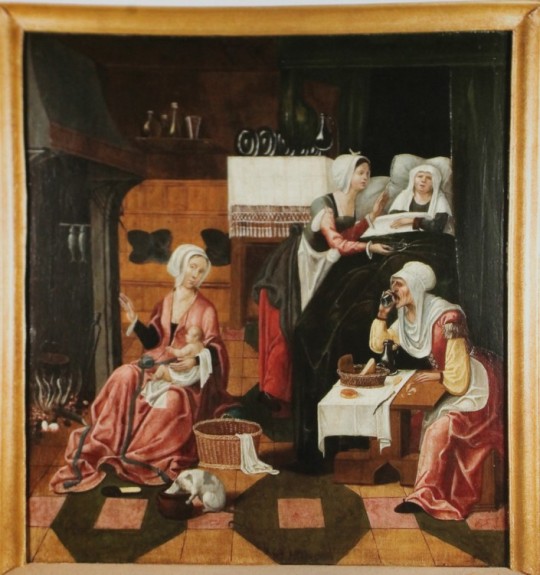
Adriaen van Overbeke - Birth of the Virgin - Petrikirche altarpiece -
Adriaen van Overbeke, Adrian van Overbeck and Adriaen van Overbeke (fl 1508 – 1529) was a Flemish Renaissance painter in the style of Antwerp Mannerism. He operated a large workshop with an important output of altarpieces, which were mainly exported to Northern France, the Rhineland and Westphalia. His known works were predominantly polychromed wooden altarpieces with painted shutters, which were created through a collaboration between painters and sculptors.
Dutch and Flemish Renaissance painting represents the 16th-century response to Italian Renaissance art in the Low Countries, as well as many continuities with the preceding Early Netherlandish painting. The period spans from the Antwerp Mannerists and Hieronymus Bosch at the start of the 16th century to the late Northern Mannerists such as Hendrik Goltzius and Joachim Wtewael at the end. Artists drew on both the recent innovations of Italian painting and the local traditions of the Early Netherlandish artists.
Antwerp was the most important artistic centre in the region. Many artists worked for European courts, including Bosch, whose fantastic painted images left a long legacy. Jan Mabuse, Maarten van Heemskerck and Frans Floris were all instrumental in adopting Italian models and incorporating them into their own artistic language. Pieter Brueghel the Elder, with Bosch the only artist from the period to remain widely familiar, may seem atypical, but in fact his many innovations drew on the fertile artistic scene in Antwerp.
Dutch and Flemish painters were also instrumental in establishing new subjects such as landscape painting and genre painting. Joachim Patinir, for example, played an important role in developing landscape painting, inventing the compositional type of the world landscape, which was perfected by Pieter Bruegel the Elder who, followed by Pieter Aertsen, also helped popularise genre painting. From the mid-century Pieter Aertsen, later followed by his nephew Joachim Beuckelaer, established a type of "monumental still life" featuring large spreads of food with genre figures, and in the background small religious of moral scenes. Like the world landscapes, these represented a typically "Mannerist inversion" of the normal decorum of the hierarchy of genres, giving the "lower" subject matter more space than the "higher". Anthonis Mor was the leading portraitist of the mid-century, in demand in courts all over Europe for his reliable portraits in a style that combined Netherlandish precision with the lessons of Titian and other Italian painters.
10 notes
·
View notes